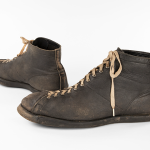Get the inside scoop on how the BSM curatorial team put together The Great Divide: Footwear in the Age of Enlightenment. From the research process and choosing artefacts to exhibition design and acquiring loans!
1) How long is the planning process for an exhibition?
The planning process for an exhibition can take between 1-3 years, depending on the size and scope of the project. The Great Divide took about two years. As 2020 is the museum’s 25th anniversary year, we knew that The Great Divide would be a special exhibition, so we began planning early on.
2) What is the most difficult part about putting together the new exhibit, The Great Divide?
The Great Divide exhibition deals with several sensitive topics including gender, race, slavery and colonialism. We wanted to make sure that we dealt with the subjects respectfully, and that there was careful thought and research behind what we are sharing with our visitors.
3) Do all artefacts have to go through conservation work prior? How long was that process?
I asked our Conservator, Ada to answer this question, and here is what she said: Every artefact is surface cleaned in preparation for display which provides a great opportunity to see if they require more significant treatment. It took approximately 3 months to complete the necessary work. Some of the 18th century shoes had received treatment for display in previous exhibitions which helped to reduce the overall workload.
4) Have any of the artefacts featured in the exhibit been displayed before?
Yes, some of the artefacts featured in this exhibition have been displayed before, but in exhibitions that have dealt with different themes and topics. This means that these artefacts are being contextualized in a new way, which will hopefully give visitors who have seen some of them before new insights into their fascinating history. What is really exciting is that we also acquired a few new artefacts for this exhibition that we are displaying for the first time. In addition, we were able to secure some loans from the Gardiner Museum and we are very happy to show these alongside footwear from our permanent collection.
5) Is there an artefact that you wanted part of the exhibition but couldn’t acquire?
We would have loved to have more men’s 18th century footwear, but these objects are very difficult to acquire. Historically, men’s fashion was not valued and preserved the way women’s clothing was. As a result, there aren’t as many surviving examples of men’s footwear compared to women’s shoes. We do have a few on display in the gallery, but we are always on the lookout for the opportunity to collect more, as it would be amazing to add early 18th century men’s shoes to our collection!
6) How did you and your design partners come up with the exhibition layout?
Our designers, Toronto-based Arc and Co, are incredible to work with. At the very outset, they understood the importance of creating a space that really reinforced the central themes of the exhibition. We also knew early on that we would use lots of contextual images in this exhibition, so the design couldn’t be too ‘busy’, as all of these elements would be overwhelming for the visitor when put together. We knew we wanted six major sections when we started out, so Arc and Co was able to design distinct areas to help us explore these themes.
7) Do you find that the contextual images shown will be useful to visitors?
We certainly hope so! All of the images are very carefully chosen to either add historical context to the artefacts, or to tell a story where we might not have the artefact in question. For example, our collection of 18th century footwear is mostly middle and upper class – as this is what was historically saved, so there are areas in the gallery where we use images to draw attention to the footwear of those who weren’t so privileged, but whose stories deserve to be told.
8) How do you go about finding contextual images to use in galleries?
Lots of online searching! We look at museum, art gallery and historic image databases online, as well as websites such as Art Resource, Bridgeman and Getty. In addition, we often find images in publications about the time period that we are discussing in a gallery.
9) How do you think people will react to the heavy important topics in the exhibit?
We hope that the exhibition gives visitors space to reflect on some of these heavy topics, and see how the effects of these enlightenment concepts continue to be felt in Western culture. There is an area at the very beginning of the exhibition where we encourage visitors to email us if they have any thoughts about how we handled these concepts, and I really look forward to hearing what visitors think.
10) What kind of messages do you hope people will away take from visiting The Great Divide?
The main message we hope that visitors will take away from this exhibition is that in 2020, we are still wrestling with many of the same concepts that individuals were dealing with in the 18th century. We continue to deal with what it means to be male, female, a child, an adult, or a racialized person in a society where white privilege continues to dominate. We continue to feel the effects of colonial systems that were strengthened throughout the 18th century. And many of these conflicts can be seen through fashion, especially footwear. At the very end of the exhibit, we invite visitors to think critically about what shoes they are wearing, and how they might relate to the subject matter explored in the exhibition, so we hope that they see the continued relevance of many of these concepts.
To learn more about The Great Divide: Footwear in the Age of Enlightenment visit our website here.



